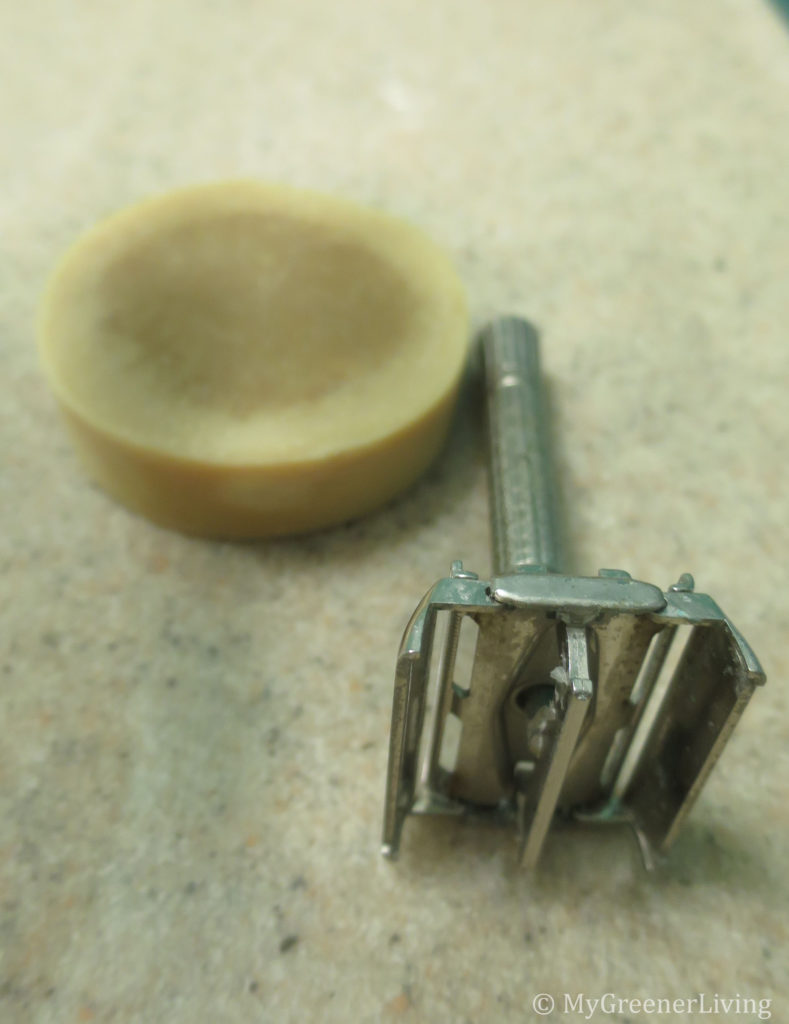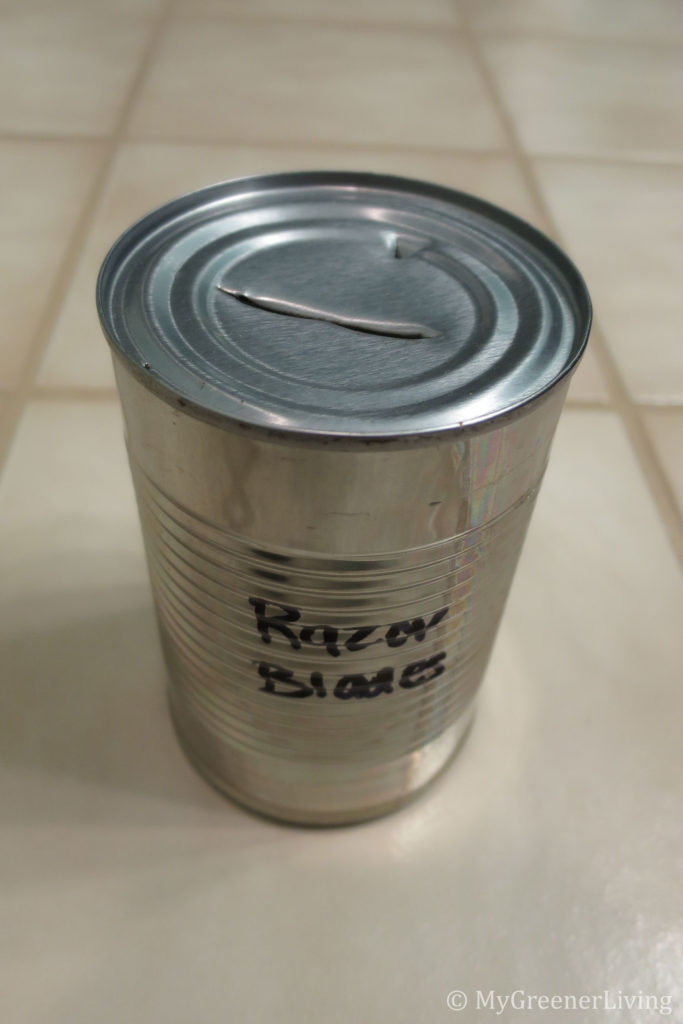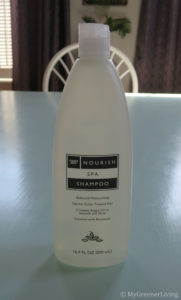In my American culture, most people shave. I used to spend more money than I wanted on disposable cartridge razors. Plus, these razors were made of multiple materials including plastic, which ended up in the trash every month or two. I would stretch their use as long as I could to try to get my money’s worth, which would result in me cutting myself on dull blades. Then I came across Trash is for Tossers’s Zero Waste Shaving post and I had my solution: the double edge safety razor.

Disclaimer: This post contains affiliate links. See my Disclosure Policy for more information.
Double Edge Safety Razors
Double edge safety razors were used throughout the twentieth century and into the twenty first century. While less common today due to the invention of the convenient disposable razor, the double edge safety razor is awesome: it’s very easy to use; I get a closer, smoother shave; and it’s inexpensive to purchase and maintain. Plus, every part of the razor and blades are recyclable!
What to buy
The double edge safety razor is another product that I recommend purchasing used. As I have seen with so many products, they just don’t make things like they used to. Quality of older razors is superb, plus you can look at the razor and see if there is rust damage from the razor’s previous use. With a new razor, you have no indication of how it will stand up to wear. Other benefits of purchasing a used double edge safety razor are cost savings and environmental benefit – as I mentioned in my Earth Day Post, resources like water and electricity go into making every new product, but these resources are saved when you buy used.
I did some research on what type of vintage razors people liked, the searched online for available razors. I settled on a Gillette Super Speed Flair Tip G-4 1961 double edge safety razor. My razor arrived clean, easy to open and close, has a good weight balance in my hand, and I have been happily using it for almost 2 years.

I also researched types of blades to use with the double edge safety razor. I purchased a 100 pack of Astra blades which are supposed to be very thin, and I am quite happy with them. The blades essentially have 4 cutting edges: the top and bottom of the two edges. Blades last me about a month in the summer and two months in the winter (when I can hide my stubbly legs under jeans). I flip the blade after 2-4 weeks depending on how frequently I am shaving.
Where to buy
I found my double edge safety razor on ebay. If you’re looking for vintage double edge safety razors, I recommend checking ebay, craigslist, Amazon, thrift stores, and yard sales. If you want to purchase a new razor, there are several companies that manufacture them and I recommend doing a Google search to find what you’re looking for.
How to use a double edge safety razor: for women
When I purchased my double edge safety razor, I read about how to use it. I knew that shaving creams and gels were formulated to work with disposable razors and wasn’t necessarily the best thing to use with the safety razor. Many instructions that I found discussed the traditional use of the double edge safety razor for shaving men’s faces, including lathering the soap with a shaving brush, working soap onto the skin to be shaved (in a small area at a time), and shaving. [Note: this is the paraphrased version. I highly recommend men looking to shave their face read more thorough guidance to check out a video on the topic.] I tried this technique once and it took forever. I knew I wouldn’t stick with it if shaving took much longer with the double edge safety razor than with a “convenience” disposable razor, so I decided to wing it and just apply soap directly from the bar to my skin. And it worked great!

How I shave: Rub the bar directly over all the skin to be shaved, then shave while holding the razor at approximately 30 degrees from the skin, and without applying pressure. Let the weight of the razor apply the pressure. Be careful around around areas like your ankles and knees since there are more contours to work around. I also use this water shutoff valve to turn off or reduce the water flow while I am applying soap and shaving, to keep the soap from being washed off and to save a little water!
Cautions: As with any razor, if you are not careful you could cut yourself. The blades for the double edge safety razor are very thin and sharp. I’ve only really cut myself once, when I when I decided to shave without my contacts in (I’m blind and can’t see that far without my contacts…). I also found that shaving while cold is much more dangerous – the double edge safety razor slices off the top of goose bumps, where the disposable cartridge razor often glides over them. Ow!
Disposal
Double edge safety razors and their blades are stainless steel, and can be recycled wherever stainless steel can be recycled. Most (all? – every one I have checked) municipal recycling facilities accept stainless steel. I made a safe blade storage container by cutting a slit about 1″ long and the width of my knife blade in the top of a can of broth. I drained the broth (and used it), rinsed the can, and let dry for several weeks. When I am ready to dispose of a blade, I drop it in the slit in the top of the can. When the can is full or when you are ready to recycle it, just recycle the can with your municipal recycling or at whatever facility to use to recycle steel.
Note: Be sure not to cut the slit in the can too wide or the blades may be able to fall out. I shook my can upside down to make sure none of the blades fell out. Now I’m confident that the opening is small enough that it is very unlikely a blade can slip out and cut someone.

Cost Comparison
Traditional disposable blade razor
Razor Handle (handle plus one or two blade cartridge): $10.00. Factoring out the cost of the blade cartridges, the cheapest I could get the handle only is $6.00
Cartridge: $3.00 (assuming purchase of a 4-pack for $12 – with coupon or one sale)
Shaving Cream: $2.50 (assuming I purchased on sale)
One cartridge and one bottle of shave gel would last at most 2 months. My monthly cost was ($3.00/2+$2.50/2=) $2.75, plus the upfront one time cost of $6.
Double edge safety razor
Razor: $23 (this varies – you can get them cheaper or more expensive)
Blade: $11 for 100 blades; $0.11 per blade
Soap (I use my own): $1.24 per 4-oz bar
One blade lasts me at least 1 month. 1-4 oz bar of my soap lasts 2 months or more. My monthly cost is ($0.11+$1.24/2=) $0.73 plus the $23 initial cost.
The upfront cost of the double edge safety razor is higher than a disposable cartridge razor, but within 9 months the double edge safety razor has paid for itself, and after that I am saving about $2/month or $24/year, plus I am helping the environment!
Have you found alternative ways to save money or resources while shaving?





